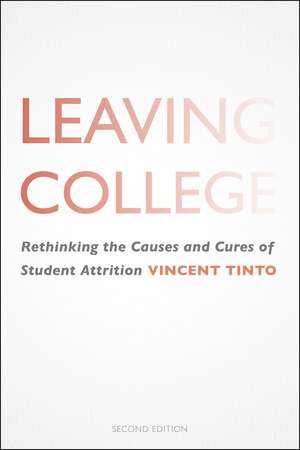Leaving College: Rethinking the Causes and Cures of Student Attrition
Autor Vincent Tintoen Limba Engleză Paperback – 3 dec 2012
In this 1994 classic work on student retention, Vincent Tinto synthesizes far-ranging research on student attrition and on actions institutions can and should take to reduce it. The key to effective retention, Tinto demonstrates, is in a strong commitment to quality education and the building of a strong sense of inclusive educational and social community on campus. He applies his theory of student departure to the experiences of minority, adult, and graduate students, and to the situation facing commuting institutions and two-year colleges. Especially critical to Tinto’s model is the central importance of the classroom experience and the role of multiple college communities.
Preț: 234.62 lei
Nou
Puncte Express: 352
Preț estimativ în valută:
44.89€ • 48.92$ • 37.83£
44.89€ • 48.92$ • 37.83£
Carte tipărită la comandă
Livrare economică 23 aprilie-07 mai
Preluare comenzi: 021 569.72.76
Specificații
ISBN-13: 9780226007571
ISBN-10: 022600757X
Pagini: 312
Ilustrații: 17 tables, 3 line drawings
Dimensiuni: 152 x 229 x 20 mm
Greutate: 0.41 kg
Ediția:1
Editura: University of Chicago Press
Colecția University of Chicago Press
ISBN-10: 022600757X
Pagini: 312
Ilustrații: 17 tables, 3 line drawings
Dimensiuni: 152 x 229 x 20 mm
Greutate: 0.41 kg
Ediția:1
Editura: University of Chicago Press
Colecția University of Chicago Press
Notă biografică
Vincent Tinto, Distinguished Professor of Education at Syracuse University, is coauthor of Where Colleges Are and Who Attends: Effects of Accessibility on College Attendance (1972).
Cuprins
Preface to the Second Edition
Acknowledgments
1. Introduction
The Dimensions and Consequences of Student Departure from Higher Education
The Limits of Our Understanding of Student Departure
The Goals and Structure of the Book
2. The Scope and Patterning of Student Departure from Higher Education
The Entry of Individuals into Higher Education
The Scope of Departure from Higher Education
Group Differences in Rates of Degree Completion
Concluding Observations
3. Roots of Individual Departure from Institutions of Higher Education
Sorting through Past Research on Student Departure
Individual Roots of Student Departure
Interactional Roots of Institutional Departure
External Communities and Withdrawal from College
Finances and College Persistence
Involvement, Learning, and Leaving
Individual and Institutional Variations in the Process of Student Departure
Concluding Observations
4. A Theory of Individual Departure from Institutions of Higher Education
Past Theories of Student Departure
Studies of Departure in Other School Settings
Stages in the Process of Departure from Institutions of Higher Education
Suicide and the Study of Departure from Higher Education
Toward a Theory of Institutional Departure from Higher Education
A Longitudinal Model of Departure from Institutions of Higher Education
Linking Learning and Leaving: The Educational Character of Student Leaving
A Model of Institutional Departure: Some Observations
5. The Dimensions of Institutional Action
Defining "Dropout" from Higher Education
The Principles of Effective Retention
The Principles of Effective Implementation
What Works in Retaining Students
Retention Policies for Different Students
Retention Policies for Different Institutions
Concluding Observations
6. Conclusions
Educational Communities and the Character of Institutional Commitment
Educational Mission and Institutional Commitment
The Paradox of Institutional Commitment and the Limits of Institutional Action
Educational Excellence, Retention, and Student Involvement in Learning
Leaving College and Other Forms of Departure
A Concluding Observation
Appendix A: The Assessment of Student Departure from Institutions of Higher Education
Appendix B: Toward a Theory of Doctoral Persistence
Notes
References
Index
Acknowledgments
1. Introduction
The Dimensions and Consequences of Student Departure from Higher Education
The Limits of Our Understanding of Student Departure
The Goals and Structure of the Book
2. The Scope and Patterning of Student Departure from Higher Education
The Entry of Individuals into Higher Education
The Scope of Departure from Higher Education
Group Differences in Rates of Degree Completion
Concluding Observations
3. Roots of Individual Departure from Institutions of Higher Education
Sorting through Past Research on Student Departure
Individual Roots of Student Departure
Interactional Roots of Institutional Departure
External Communities and Withdrawal from College
Finances and College Persistence
Involvement, Learning, and Leaving
Individual and Institutional Variations in the Process of Student Departure
Concluding Observations
4. A Theory of Individual Departure from Institutions of Higher Education
Past Theories of Student Departure
Studies of Departure in Other School Settings
Stages in the Process of Departure from Institutions of Higher Education
Suicide and the Study of Departure from Higher Education
Toward a Theory of Institutional Departure from Higher Education
A Longitudinal Model of Departure from Institutions of Higher Education
Linking Learning and Leaving: The Educational Character of Student Leaving
A Model of Institutional Departure: Some Observations
5. The Dimensions of Institutional Action
Defining "Dropout" from Higher Education
The Principles of Effective Retention
The Principles of Effective Implementation
What Works in Retaining Students
Retention Policies for Different Students
Retention Policies for Different Institutions
Concluding Observations
6. Conclusions
Educational Communities and the Character of Institutional Commitment
Educational Mission and Institutional Commitment
The Paradox of Institutional Commitment and the Limits of Institutional Action
Educational Excellence, Retention, and Student Involvement in Learning
Leaving College and Other Forms of Departure
A Concluding Observation
Appendix A: The Assessment of Student Departure from Institutions of Higher Education
Appendix B: Toward a Theory of Doctoral Persistence
Notes
References
Index
